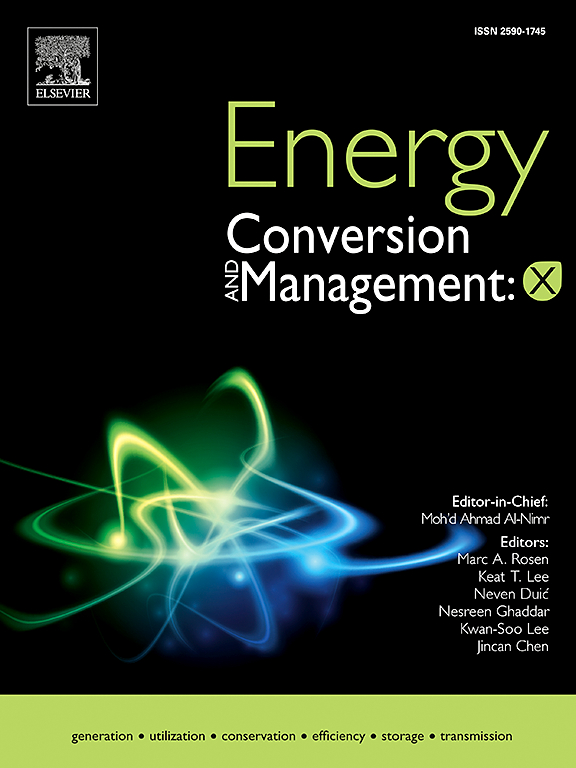地热离网系统有机朗肯循环配置的多目标优化:电力、DHW和氢气生产
IF 7.6
Q1 ENERGY & FUELS
引用次数: 0
摘要
本研究探讨了利用地热能为建筑物提供电力负荷和生活热水(DHW)的离网系统的优化。该系统通过有机朗肯循环(ORC)发电,多余的能量被输送到电解槽用于制氢。伊朗大不里士(Tabriz)的一个住宅综合体,有408名住户,被选为案例研究,利用地热发电的可用性。对基本型、带再热器型和蓄热型三种ORC结构进行了能量、能源和经济性优化。优化过程采用非支配排序遗传算法II (NSGA-II),旨在最大限度地提高能源和物用效率,氢气产量,最小化电力(LCOE)和氢气(LCOH)的平均成本,同时确保满足电力和DHW需求。结果表明,RORC结构在各方面都优于其他两个循环:其产生的功率比RHORC高44.45%,比ORC高47.86%,能量和㶲效率分别为49.03%和47.01%。此外,RORC比RHORC多产生63.81%的氢,比ORC多产生69.37%的氢。此外,RORC具有最低的LCOE(4.52美分kWh−1)和LCOH(2.69美分kWh−1)。本文章由计算机程序翻译,如有差异,请以英文原文为准。
3E multi-objective optimization of Organic Rankine Cycle configurations for a geothermal off-grid system: Power, DHW, and hydrogen production
This study investigates the optimization of an off-grid system for supplying electrical load and domestic hot water (DHW) to a building using geothermal energy. The system generates power through an Organic Rankine Cycle (ORC), with excess energy directed to an electrolyzer for hydrogen production. A residential complex in Tabriz, Iran, with 408 occupants, was selected as the case study, leveraging the availability of geothermal power. Three ORC configurations—basic ORC, ORC with reheater (RHORC), and regenerative ORC (RORC) were optimized in terms of energy, exergy, and economy. The optimization process utilized the Non-Dominated Sorting Genetic Algorithm II (NSGA-II), aiming to maximize energy and exergy efficiency, hydrogen production, and minimize levelized costs of electricity (LCOE) and hydrogen (LCOH), while ensuring that electrical and DHW demands are met. The results demonstrate that the RORC configuration outperforms the other two cycles in all aspects: it produces 44.45 % more power than RHORC and 47.86 % more than ORC, with energy and exergy efficiencies of 49.03 % and 47.01 %, respectively. Furthermore, RORC generates significantly more hydrogen 63.81 % more than RHORC and 69.37 % more than ORC. Additionally, RORC has the lowest LCOE (4.52 cent. kWh−1) and LCOH (2.69 cent. kWh−1).
求助全文
通过发布文献求助,成功后即可免费获取论文全文。
去求助
来源期刊

Energy Conversion and Management-X
Multiple-
CiteScore
8.80
自引率
3.20%
发文量
180
审稿时长
58 days
期刊介绍:
Energy Conversion and Management: X is the open access extension of the reputable journal Energy Conversion and Management, serving as a platform for interdisciplinary research on a wide array of critical energy subjects. The journal is dedicated to publishing original contributions and in-depth technical review articles that present groundbreaking research on topics spanning energy generation, utilization, conversion, storage, transmission, conservation, management, and sustainability.
The scope of Energy Conversion and Management: X encompasses various forms of energy, including mechanical, thermal, nuclear, chemical, electromagnetic, magnetic, and electric energy. It addresses all known energy resources, highlighting both conventional sources like fossil fuels and nuclear power, as well as renewable resources such as solar, biomass, hydro, wind, geothermal, and ocean energy.
 求助内容:
求助内容: 应助结果提醒方式:
应助结果提醒方式:


